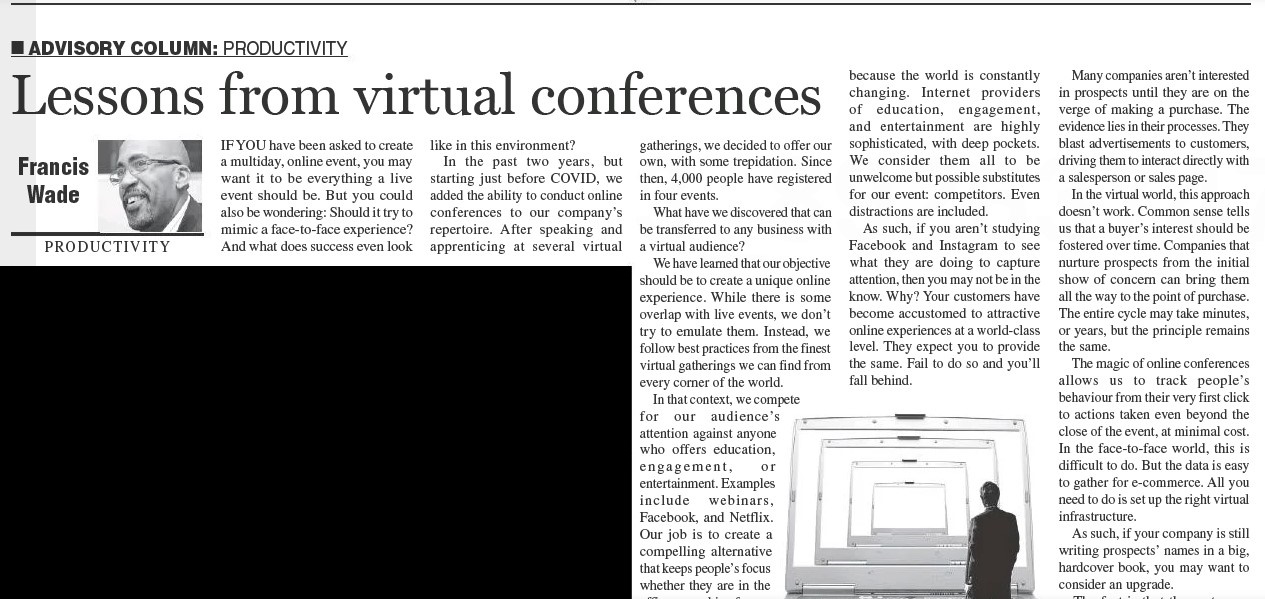If you have been asked to create a multi-day, online event, you may want it to be everything a live event should be. But you could also be wondering: should it try to mimic a face-to-face experience? And what does success even look like in this environment?
In the past two years, (but starting just before COVID), we added the ability to conduct online conferences to our company’s repertoire. After speaking and apprenticing at several virtual gatherings, we decided to offer our own…with some trepidation. Since then, 4,000 people have registered in four events.
What have we discovered that can be transferred to any business with a virtual audience?
- Quality Attention Counts
We have learned that our objective should be to create a unique online experience. While there is some overlap with live events, we don’t try to emulate them. Instead, we follow best practices from the finest virtual gatherings we can find from every corner of the world.
In that context, we compete for our audience’s attention against anyone who offers education, engagement or entertainment. Examples include webinars, Facebook and Netflix. Our job is to create a compelling alternative that keeps people’s focus whether they are in the office or working from home.
This definition has kept us on the edge of our seats, because the world is constantly changing. Internet providers of education, engagement and entertainment are highly sophisticated, with deep pockets. We consider them all to be unwelcome, but possible substitutes for our event: “competitors”. Even distractions are included.
As such, if you aren’t studying Facebook and Instagram to see what they are doing to capture attention, then you may not be in the know. Why? Your customers have become accustomed to attractive online experiences at a world-class level. They expect you to provide the same. Fail to do so and you’ll fall behind.
- Grow a Pipeline
Many companies aren’t interested in prospects until they are on the verge of making a purchase. The evidence lies in their processes. They blast advertisements to customers, driving them to interact directly with a salesperson, or sales page.
In the virtual world, this approach doesn’t work. Common sense tells us that a buyer’s interest should be fostered over time. Companies which nurture prospects from the initial show of concern can bring them all the way to the point of purchase. The entire cycle may take minutes, or years, but the principle remains the same.
The magic of online conferences allows us to track people’s behavior from their very first click to actions taken even beyond the close of the event…at a minimal cost. In the face-to-face world, this is difficult to do. But the data is easy to gather for ecommerce. All you need to do is set up the right virtual infrastructure.
As such, if your company is still writing prospects’ names in a big, hardcover book, you may want to consider an upgrade.
The fact is, the customer relationship software used to manage a database of thousands of prospects costs relatively little. Unfortunately, the skills required to run it are in desperately short supply, but the sooner you make the investment, the better.
- Invest in Analytics
Even after you gain the attention and put in place the necessary software, your journey has just begun. Fortunately, even entry-level applications allow you to collect metrics.
Use them to predict the flow of your prospects from one phase to the next, the effectiveness of your messaging and the precise impact of the final results you produce. This knowledge means that you can make tweaks that have a positive effect.
While your company may have reached its current position without these capabilities, I assert that it has no future unless it masters them. Why? We live in a world in which every organization can be out-analyzed by a substitute or competitor.
Perhaps you think this to be an exaggeration, but as you read these words, consider the medium you are reading: paper or digital?
As you probably know, there is a major transformation underway in the newspaper industry. As a reader of this column, you’re involved. In fact, the Gleaner’s future depends on understanding your behaviors. Using the data it can gather from paper and digital customers, new strategies are being implemented. There simply is no choice.
The transitions taking place in the conference industry are also unavoidable. As new tools become available, the online versions have the means to get better, faster. This gives them a great advantage over traditional counterparts. It’s just an example of yet another business being disrupted by analytic technology.

